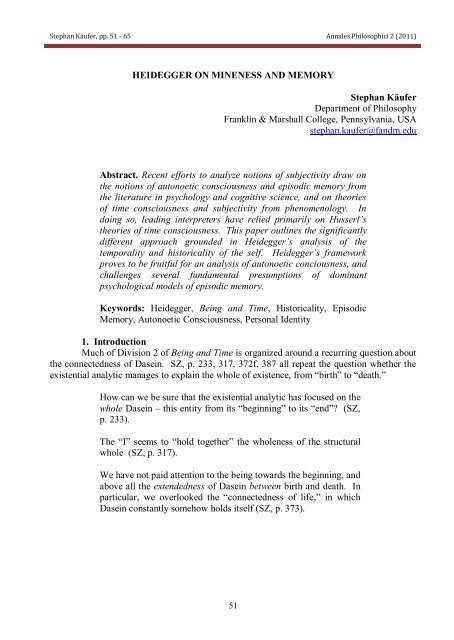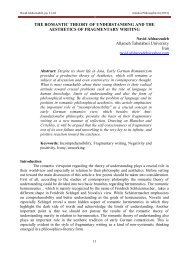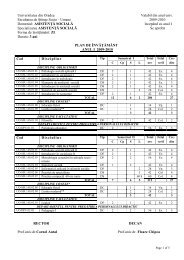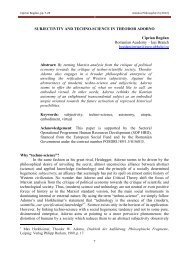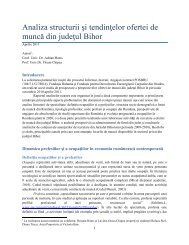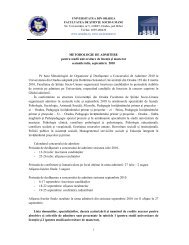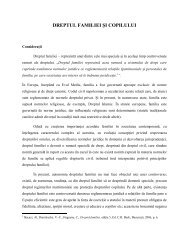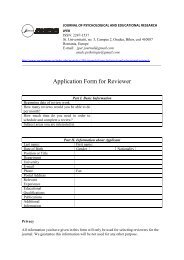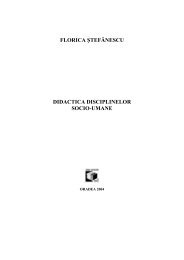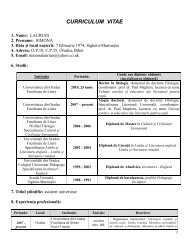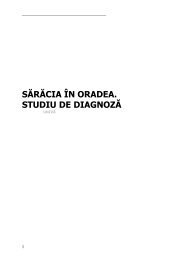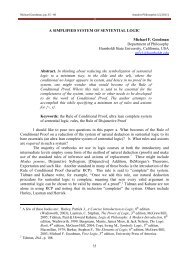Stephan Käufer: HEIDEGGER ON MINENESS AND MEMORY
Stephan Käufer: HEIDEGGER ON MINENESS AND MEMORY
Stephan Käufer: HEIDEGGER ON MINENESS AND MEMORY
Create successful ePaper yourself
Turn your PDF publications into a flip-book with our unique Google optimized e-Paper software.
<strong>Stephan</strong> <strong>Käufer</strong>, pp. 51 - 65 Annales Philosophici 2 (2011)<br />
<strong>HEIDEGGER</strong> <strong>ON</strong> <strong>MINENESS</strong> <strong>AND</strong> <strong>MEMORY</strong><br />
<strong>Stephan</strong> <strong>Käufer</strong><br />
Department of Philosophy<br />
Franklin & Marshall College, Pennsylvania, USA<br />
stephan.kaufer@fandm.edu<br />
Abstract. Recent efforts to analyze notions of subjectivity draw on<br />
the notions of autonoetic consciousness and episodic memory from<br />
the literature in psychology and cognitive science, and on theories<br />
of time consciousness and subjectivity from phenomenology. In<br />
doing so, leading interpreters have relied primarily on Husserl‟s<br />
theories of time consciousness. This paper outlines the significantly<br />
different approach grounded in Heidegger‟s analysis of the<br />
temporality and historicality of the self. Heidegger‟s framework<br />
proves to be fruitful for an analysis of autonoetic conciousness, and<br />
challenges several fundamental presumptions of dominant<br />
psychological models of episodic memory.<br />
Keywords: Heidegger, Being and Time, Historicality, Episodic<br />
Memory, Autonoetic Consciousness, Personal Identity<br />
1. Introduction<br />
Much of Division 2 of Being and Time is organized around a recurring question about<br />
the connectedness of Dasein. SZ, p. 233, 317, 372f, 387 all repeat the question whether the<br />
existential analytic manages to explain the whole of existence, from ―birth‖ to ―death.‖<br />
How can we be sure that the existential analytic has focused on the<br />
whole Dasein – this entity from its ―beginning‖ to its ―end‖? (SZ,<br />
p. 233).<br />
The ―I‖ seems to ―hold together‖ the wholeness of the structural<br />
whole (SZ, p. 317).<br />
We have not paid attention to the being towards the beginning, and<br />
above all the extendedness of Dasein between birth and death. In<br />
particular, we overlooked the ―connectedness of life,‖ in which<br />
Dasein constantly somehow holds itself (SZ, p. 373).<br />
51
Annales Philosophici 2 (2011) <strong>Stephan</strong> <strong>Käufer</strong>, pp. 51 - 65<br />
It remains a riddle, how this happening as fate is supposed to<br />
constitute the whole ―connectedness‖ of Dasein from birth to death<br />
(SZ, p. 387). 1<br />
Part of the question is about what ―holds Dasein together‖ and the answer to this lies<br />
in Heidegger‘s existential notion of the self, as a unity implicit in the care-structure. With this<br />
existential notion, i.e. with an account of the self as disposed ability, Heidegger argues against<br />
interpretations of life, according to which human life is a ―sum total of momentary realities of<br />
successively arriving and disappearing experiences‖ (SZ, p. 374) and the self is something<br />
that unifies this totality of ―time-slices.‖ This general criticism covers a range of views of the<br />
self: Kant‘s transcendental apperception, Locke‘s psychological continuity, and several views<br />
from Husserl. It can also be used to address more recent analyses of the self that emphasize<br />
the role of episodic memory in constituting the self by connecting together diachronically<br />
distinct experiences. 2 In particular, it puts Heidegger fundamentally at odds with the<br />
groundbreaking views on the self and subjectivity developed by Shawn Gallagher and Dan<br />
Zahavi, who draw on the resources of both phenomenology and current cognitive science. 3<br />
For Heidegger the question about connectedness is not primarily about consciousness,<br />
or even unconscious experiences. This is a fundamental difference between Heidegger and<br />
the approach to the persistence of the self over time in Husserl, Gallagher, Zahavi and most of<br />
the contemporary literature. 4 Because Heidegger does not think that consciousness is directly<br />
relevant to the continuity or unity of Dasein over time, he almost never mentions memory as<br />
such. Of course he uses a lot of temporal language and concepts that have to do with memory<br />
in some way: Gegenwärtigen, Wiederholen, Gewesen, Geschichte, and Vergessen. He uses<br />
Erinnerung twice in the temporality chapter, to point out that temporality is not about<br />
memory. So, the temporality of anxiety, i.e. the way it brings you back to your thrownness, is<br />
not a kind of remembering: ―This bringing back does not have the character of a forgetful<br />
avoiding, nor of remembering‖ (SZ, p. 343). And in discussing the temporality of<br />
1 All translations from Heidegger in this paper are my own. Page references throughout are to the<br />
German editions of Sein und Zeit and the Gesamtausgabe.<br />
2 For the most parts such views follow in the general footsteps of Locke‘s ontology, and there is a big<br />
variety of them. An extreme form is the conception of the self as a narrative, which can<br />
be found in Ricoeur, MacIntyre, the psychologist Dan McAdams, maybe Dennett, and<br />
Velleman. What you are, and what unifies your time-slices, is a narrative that you spin,<br />
with the help of your community and culture, over the course of your life. Constructing<br />
such a narrative depends on your ability to recollect and reinterpret past episodes of your<br />
life.<br />
3 See especially Zahavi, D. Subjectivity and Selfhood: Investigating the First-Person Perspective,<br />
Cambridge: MIT Press, 2005; and Gallagher, S. and D. Zahavi, The Phenomenological<br />
Mind, London: Routledge, 2008.<br />
4 Consider what Heidegger says about moods in Fundamental Concepts: ―They reach down into our<br />
essence in a more originary way than thinking or acting; in them we first come upon<br />
ourselves, as a Da-sein‖ (GA29/30, p. 102). In analyzing moods ―we won‘t get anywhere<br />
with the distinction between ‗conscious‘ and ‗unconscious.‘ To awaken a mood cannot<br />
simply mean to bring a previously unconscious mood to consciousness. It means to let it<br />
awaken, and to let it be as such. However, when we bring a mood to consciousness,<br />
know about it and make it the object of knowledge, then we achieve the opposite of<br />
waking it. The mood is then destroyed, or at least not reinforced, but made weaker, and<br />
changed‖ (GA29/30, p. 93; cf. SZ, p. 286).<br />
52
<strong>Stephan</strong> <strong>Käufer</strong>, pp. 51 - 65 Annales Philosophici 2 (2011)<br />
understanding he points out that forgetfulness (Vergessenheit), as the inauthentic mode of<br />
having-been, ―is not merely a lack of remembering… but a positive, ecstatic mode of<br />
beenness.‖ In an important passage he writes: ―Remembering is only possible on the ground<br />
of forgetting, and not vice versa. For, in the mode of forgetfulness, beenness first ―discloses‖<br />
the horizon into which a Dasein that is lost in the ―externality‖ of its dealings can remember‖<br />
(SZ, p. 339). 5<br />
Heidegger does not pick out a more fundamental role of memory, because he thinks it<br />
is only one way of elaborating the general scheme of human life that he finds ontologically<br />
misguided. Heidegger uses the term ―connectedness‖ (Zusammenhang) to pick out this<br />
general scheme. Memory is one explanation of connectedness, perhaps the preferred<br />
explanation. But there are other ways of explaining the persistence of the self through diverse<br />
experiences. Kant‘s ―I think‖ is one such way, and Husserl‘s inner time-consciousness is<br />
another. Gallagher and Zahavi also use the broader notion of a connectedness to make sense<br />
of memory, using the metaphor of glue: ―Our everyday experiences are normally permeated<br />
with a kind of temporal super-glue‖ – by which they mean a Husserlian retention-intentionprotention<br />
structure – and ―memory, with a weaker sort of glue, provides a larger framework<br />
for making sense of our experiences‖ (2008, p. 85).<br />
I want to show how Heidegger‘s existential ontology accommodates views on<br />
episodic memory and the unity of the self. In other words, I want to outline a Heideggerian<br />
approach to the basic phenomena of memory-based conceptions of the self. To do so, I first<br />
explain the relevant elements of Heidegger‘s analysis of Dasein‘s historicality (section 2).<br />
Then, I proceed to a phenomenology of the autonoetic component of episodic memory<br />
(section 3). I will end with five Heideggerian theses about episodic memory and autonoetic<br />
consciousness (section 4).<br />
2. Dasein’s Historicality<br />
Heidegger‘s basic answer to the connectedness worry comes in chapter 5 of Division<br />
2, the historicality chapter. Here he argues that the conception of the self as connected or<br />
unified over time is ontologically obscure, even though it is ―justified and sufficient within its<br />
limits‖ (SZ, p. 374). On Heidegger‘s view, ―connectedness‖ and diachronic identity derive<br />
from his existential notion of extendedness (Erstreckung).<br />
Gallagher and Zahavi interpret Heidegger‘s notion of extendedness in their section on<br />
―historicity‖ (which is how they translate Geschichtlichkeit). They take extendedness to be an<br />
―implicit memory‖ through which ―people are influenced by past experience without any<br />
explicit awareness that this is the case‖. They go on:<br />
Human reality is characterized by a kind of temporal stretch. The<br />
past continually serves as the horizon and background of our<br />
present experience, and when absorbed in action, our focus, the<br />
center of our concern, is not on the present, but on the future goals<br />
that we intend or project. The future is salient while the present<br />
and the past constitute its background. To be human is already to<br />
be situated in the world, born (or thrown – as some<br />
phenomenologists say) into it without having chosen to be so, to be<br />
5 Note that prima facie this passage suggests that only inauthentic Dasein remembers.<br />
53
Annales Philosophici 2 (2011) <strong>Stephan</strong> <strong>Käufer</strong>, pp. 51 - 65<br />
present to my surroundings, to be ahead of oneself in future<br />
projects (2008, p. 85f).<br />
Gallagher and Zahavi fit historicality, or historicity, into their framework for<br />
conceiving of human life as occurring over a succession of experiences. Hence historicity, for<br />
them, is a kind of subterranean memory and Dasein‘s extendedness, or ―stretch,‖ consists of<br />
the continuing influence of past experiences on present experience and intended future goals.<br />
An example of our historicity, according to them, is an impairment of our source memory: I<br />
see a headline about Being and Time being a work of Nazi propaganda in the New York Times,<br />
then I forget where I read this, or even that I read this, but I find myself with an aversion to<br />
this book.<br />
This reading goes against the grain of Heidegger‘s basic argument. Note that on this<br />
Gallagher/Zahavi view, the extendedness Heidegger talks about in the historicity chapter<br />
derives from the self‘s ability to unify diachronic experience by means of memory.<br />
Heidegger, however, asserts the opposite of this. Extendedness is supposed to explain how<br />
the ―connectedness of life,‖ including the unity of diachronically distinct experiences, is<br />
possible in the first place.<br />
Dasein does not first fill up a somehow occurrent track or stretch<br />
[Strecke] ―of life‖ with the phases of its momentary reality, but it<br />
extends [erstreckt] itself in such a way that its own being is already<br />
constituted as extendedness [Erstreckung] (SZ, p. 374). 6<br />
This needs to be explained.<br />
To frame his question Heidegger introduces the semi-technical notion of ―birth‖. It is<br />
a semi-technical notion because, on the one hand, Heidegger does not use it with its ordinary<br />
meaning. He uses it in a sense that reflects his use of ―death‖ as a particular feature of<br />
existence (your ownmost, non-relational possibility that never ceases to be relevant); and just<br />
like ―death,‖ Heidegger wants to take advantage of the ordinary connotations of the word<br />
while also maintaining that he is not literally talking about birth. He makes this clear enough<br />
by saying, for example:<br />
Understood existentially, birth is never something past in the sense<br />
of a no longer occurrent thing, just as death does not have the<br />
mode of being of something that has not yet occurred and is<br />
impending. Factical Dasein exists as born (gebürtig) and as born<br />
(gebürtig) it also already dies, in the sense of being-towards death<br />
(SZ, p. 374). 7<br />
On the other hand, Heidegger does not provide a detailed phenomenological<br />
interpretation of this existential notion of birth. He uses the word a few times in §72 (pp. 373,<br />
374) to worry about the notion of a continuous expanse from birth to death, and then again in<br />
§74 (p. 390) when he answers that worry in terms of Dasein‘s extended constancy. In<br />
6 Heidegger‘s ironic use of füllt…auf might indicate that one of his proximal targets here is Husserl.<br />
7 In German we say Ich bin gebürtiger Hamburger (cf. ―German-born‖ or ―natural-born‖), which has<br />
Heidegger‘s intended connotation of having been born and (therefore) continuing to be<br />
as.<br />
54
<strong>Stephan</strong> <strong>Käufer</strong>, pp. 51 - 65 Annales Philosophici 2 (2011)<br />
working out this answer, Heidegger relies on other concepts associated with the originary past<br />
of Dasein‘s temporality: thrownness, facticity, repeating (Wiederholen) and handing down<br />
(überliefern). 8<br />
Heidegger is clear that the entire analysis of historicality in chapter 5 is rooted in his<br />
account of Dasein‘s temporality in chapter 3 (especially section 65) and chapter 4. All the<br />
basic notions of historicality are defined in terms of temporality. He writes, ―it turns out that<br />
the interpretation of the historicality of Dasein is basically just a more concrete elaboration of<br />
temporality‖ (SZ, p. 382). So historicality is not another existential feature besides<br />
temporality, but a way to spell it out in more concrete detail. The concreteness Heidegger<br />
wants to add lies in the specific possibilities that, in each case, Dasein exists as. While the<br />
existential analytic cannot say anything specific about actual possibilities of actual people, it<br />
can, he writes, ―ask in general, from where the possibilities are drawn, onto which Dasein in<br />
fact projects itself‖ (SZ, p. 383). The basic question Heidegger is seeking to answer with his<br />
analysis of historicality, then, is simply this: Why are these possibilities my possibilities?<br />
What explains, or what makes it possible, that a specific, concrete existence projects itself<br />
onto, or understands itself in terms of, specific possibilities? 9<br />
The basic answer has to do with taking over possibilities in coming back to your<br />
thrownness. Heidegger writes:<br />
Resoluteness, in which you come back to yourself, in each case<br />
discloses factical possibilities of authentic existing from the culture<br />
which, as thrown, you take on (übernimmt). Such resolute coming<br />
back to thrownness harbors within it a handing down to yourself<br />
(Sichüberliefern) of received (überkommener) possibilities (SZ, p.<br />
383).<br />
Most of this – namely the part about ―coming back to yourself‖ – repeats a central<br />
claim of Heidegger‘s analysis of temporality. The unity of the originary future, past and<br />
present makes up the being of care, and hence the structure of the self. The originary future is<br />
―maintaining a possibility as a possibility and in so doing letting yourself come towards<br />
yourself‖ (SZ, p. 325). You can only come towards yourself by way of coming back: ―Only<br />
insofar as you are as ‗I have-been‘ can you futurally come towards yourself in such a way that<br />
you come back‖ (SZ, p. 326). So it is part of the structure of temporality that in existing you<br />
come towards yourself by coming back to your beenness, to what you ―have-been‖.<br />
To illustrate this with an example: Say you are a philosophy professor listening to a<br />
paper at a conference. ―Letting yourself come towards yourself‖ here means, first, to project<br />
yourself onto this possibility, or (another way to say the same thing) to understand yourself in<br />
terms of this possibility, or (yet another way to say the same thing) to know how to be a<br />
professor at a conference. So your competences are deployed for the sake of being a<br />
professor. You know how to listen, strain, close your eyes, tilt your head etc. You know what<br />
to focus on and what to ignore, honing in on the drone of the speaker‘s voice, while blocking<br />
out the murmur of the wind outside. You also know how to carry yourself, when to chuckle,<br />
8 One way to think of birth is to spell out the analogy with death. Death is the possibility that closes<br />
down all other possibilities. So birth, we might say, is a feature of Dasein that opens up<br />
all possibilities.<br />
9 Here lurks another reading of birth: Death, as Dasein‘s ownmost possibility, constitutes Dasein‘s<br />
mineness. So birth, we might say, accounts for the ―thisness.‖<br />
55
Annales Philosophici 2 (2011) <strong>Stephan</strong> <strong>Käufer</strong>, pp. 51 - 65<br />
when to frown, and so on. Second, you come towards yourself by ―coming back to what you<br />
have-been‖. This means that in deploying all this know-how you also find yourself disposed<br />
in determinate ways. So the murmur of the wind or creaking of floorboards affects you as<br />
unimportant background noise, the echoing room as too large, the speaker‘s voice too low.<br />
Your disposedness and know-how work together, as it were. You listen for the sake of<br />
―coming towards yourself‖ as a professor. At the same time, your listening already discloses<br />
the situation in a ―professorish‖ way, and so you are coming towards yourself as you already<br />
find yourself. The Dasein that you are coming towards is the one that you already are. This<br />
is what Heidegger means by saying that you can only come towards yourself ―in such a way<br />
that you come back.‖<br />
What is new, in this passage from the historicality chapter, is the claim about<br />
―delivering‖ or ―handing possibilities down to yourself.‖ Roughly this means that you find<br />
yourself thrown into a world and the possibilities in terms of which you understand yourself,<br />
or for the sake of which you exist, somehow emerge from that world.<br />
Proximally and for the most part the self is lost in the anyone, and<br />
it understands itself in terms of the existence-possibilities that are<br />
around in today‘s average public construal of Dasein (SZ, p. 383).<br />
Authentic existentiell understanding does not withdraw from this<br />
received construal; rather it resolutely seizes the chosen possibility<br />
in terms of this construal, and against it, and yet again for it (SZ, p.<br />
383).<br />
Being a philosophy professor and participating in philosophy conferences are<br />
possibilities in this world, so you can be a philosophy professor as one does, or you can seize<br />
this possibility resolutely. No matter what, the question remains how these possibilities are<br />
your possibilities, and here it is not enough to say that being a philosophy professor is<br />
something one can do today (while being a court jester no longer is).<br />
Heidegger‘s point here is that delivering the chosen inherited possibility or delivering<br />
yourself is the same thing. You are what you are able to be. Consider our example. In<br />
―coming back to your thrownness‖ you hand down or ―deliver to yourself‖ received<br />
possibilities. The possibility, in this example, is existing as a philosophy professor. This<br />
possibility is an ability-to-be, a Seinkönnen, consisting of the appropriate know-how and being<br />
attuned to the right kinds of solicitations. You come back to yourself insofar as your knowhow<br />
discloses the situation in unison with how you find yourself disposed to it. Thus<br />
disclosing the situation, you are already in it. In other words, you do not skillfully and<br />
attunedly disclose a situation in which one can then (choose to) exist as a philosophy<br />
professor or not; rather you disclose the situation by being one.<br />
This possibility is received or traditional (überkommen) because of your thrownness.<br />
In §29 on Da-sein as disposedness Heidegger writes:<br />
Dasein is, explicitly or not, disposed in its thrownness. In<br />
disposedness Dasein is always already brought before itself, it has<br />
always already found itself, not as a perceptual coming across<br />
itself, but as an attuned being-itself-disposed (gestimmtes<br />
Sichbefinden, SZ, p. 135).<br />
56
<strong>Stephan</strong> <strong>Käufer</strong>, pp. 51 - 65 Annales Philosophici 2 (2011)<br />
You are always disposed, and you are always disposed in your thrownness, which is<br />
what Heidegger says you come back to. This means that the specific way you find yourself<br />
solicited by aspects of your situation is prefigured by the facticity of your Überantwortung.<br />
Your thrownness dictates that you can find yourself in the conference as a professor; perhaps<br />
you could find yourself here as a stenographer. But not as a scribe or amanuensis. If you<br />
make a conscious effort to develop the skills of a scribe, i.e. carefully copying manuscripts by<br />
hand, it will come out as something else, a calligrapher or research assistant perhaps. There<br />
are professorish skills and attunements in the ―there,‖ but there are no longer scribe-ish ones.<br />
As quoted above, you disclose the situtation and can only disclose the situation by taking on<br />
(übernehmen) these skills and attunements.<br />
Resoluteness, in which you come back to yourself, in each case<br />
discloses the factical possibilities of authentic existing from the<br />
culture (Erbe) which, as thrown, you take on (SZ, p. 383).<br />
Delivering yourself or delivering possibilities then consists in taking on a culture or a<br />
heritage in taking up available skills and attunements, resolutely or not.<br />
So Heidegger‘s answer to the basic question of the historicality chapter – why are<br />
these possibilities my possibilities? – consists of a bi-directional claim. On the one hand these<br />
possibilities are mine because I take them on. Authentically or not, I exercise the know-how<br />
of an ability-to-be, and I find myself responsive to the solicitations appropriate to this ability.<br />
On the other hand, I take on these skills and attunements because only in doing so can I be a<br />
self at all. The only way for the temporal structure of care to engage, i.e. the only way for<br />
Dasein to exist, as a self determined by mineness, is to take on received possibilities.<br />
Heidegger defines extendedness in terms of this sketch of an authentic way of taking<br />
on a possibility grounded in the received culture. Extendedness is the unity of the temporal<br />
ecstases in historical existing as a possibility. Your existence is extended, temporally<br />
extended, insofar as your future and your beenness are unified, i.e. insofar as in existing for<br />
the sake of a possibility (i.e. the futural ecstasis of coming-towards with its horizonal schema<br />
of for-the-sake-of) you come back to your thrownness (i.e. the past ecstasis of having-been<br />
with its horizonal schema of in-the-face-of). This is how you ―hold birth and death and their<br />
‗inbetween‘ ‗encompassed‘ [einbezogen] in your existence‖ (SZ, p. 390).<br />
Heidegger emphasizes two aspects of extendedness. First, it is a feature of constancy.<br />
Constancy is the sameness or self-identity of Dasein. Heidegger first addresses it in §64 on<br />
―Care and Selfhood,‖ in preparation for the analysis of originary temporality. Here, now, he<br />
answers the question raised there. In particular he writes that<br />
Constancy does not first form itself by cobbling together timeslices;<br />
rather these arise from already extended temporality (SZ, p.<br />
391).<br />
So constancy is not a constructed unity of the self, but an underlying one. Heidegger<br />
has a helpful discussion of his existential notion of self-sameness in his Kant lectures. There<br />
he writes:<br />
The self must be able to identify itself as existing. It must be able<br />
to understand itself in every concrete instance as the self-same<br />
57
Annales Philosophici 2 (2011) <strong>Stephan</strong> <strong>Käufer</strong>, pp. 51 - 65<br />
futural-having-been, uniting the resolution [Entschluß] to a<br />
possibility and the commitment [Verpflichtung] to the past. This<br />
displacing-yourself-into-yourself [Sich-in-sich-versetzen],<br />
extending into all dimensions of temporality, makes up the real<br />
concept, the existential concept of self-identification (GA25, p.<br />
395).<br />
So Heidegger takes seriously the prominent inclination in the history of philosophy to<br />
define the self in terms of a self-identification. But he does not think this self-identification is<br />
cognitive like Kant‘s ―I think,‖ or reflective like Husserl‘s transcendental ego. Instead, he<br />
says here, it is existential, and that means it a disposed ability. More precisely, it is the way in<br />
which ability-to-be and finding-yourself-disposed, Seinkönnen and Sichbefinden are unified,<br />
and in so being unified constitute the mineness of existence. Extendedness is a feature of this,<br />
i.e. constancy is always extended constancy, because extendedness is just Heidegger‘s name<br />
for the ecstatic unity of originary future and past; this is how ability and disposedness, resolve<br />
and commitment are united.<br />
Second, Heidegger emphasizes that extendedness constitutes an immediate openness<br />
to the past.<br />
In fateful repeating of possibilities that have been, Dasein brings<br />
itself back ―immediately,‖ i.e. temporally-ecstatically, to that<br />
which has been before it (SZ, p. 390f).<br />
It is immediate insofar as you do not first require a representation, or a re-experience,<br />
or a memory in order to exist in terms of the past. Your beenness, i.e. the way you find<br />
yourself disposed on the basis of taking on a possibility as your own, is an immediate,<br />
constitutive part of being you.<br />
We now have a sketch of Heidegger‘s existential ontology of the self as a temporally<br />
extended, constant, skillful and disposed ability that takes on or takes over possibilities from<br />
its culture. The main question of this paper still remains open. How does this ontology<br />
account for the supposedly derivative phenomena of the unity of the self over time in the<br />
ordinary sense? What does Heidegger‘s insistence on the unity of the temporal ecstases<br />
contribute to worries about the connectedness of occurrent time-slices? Heidegger himself<br />
raises this very question. After explaining authentic historicality he asks how all this stuff<br />
about fate is supposed to constitute the connectedness of life (SZ, p. 387). It might seem as if<br />
he avoids answering the question in his section on inauthentic historicality; here he merely<br />
argues that questions about the unity of the self over time are badly formulated and arise from<br />
the ―irresoluteness that makes up the in-constancy of a self‖ which is dispersed in<br />
disconnected experiences and worldly events (SZ, p. 390). Heidegger actually makes an<br />
important point about the diachronic connectedness views in general, and memory-based<br />
accounts in particular. In order to understand his point, we fist need to take a closer look at<br />
the role of episodic memory in contemporary accounts of the self.<br />
58
<strong>Stephan</strong> <strong>Käufer</strong>, pp. 51 - 65 Annales Philosophici 2 (2011)<br />
3. Episodic Memory and Re-experience<br />
It has become fairly standard among people who concern themselves with memory<br />
(philosophers, psychologist, cognitive scientists, cognitive neurologists) to accept a distinction<br />
between four different types of memory: 10<br />
Short-term, or working memory: You can remember a phone number long<br />
enough to dial it, and the beginning of a sentence or paragraph long enough to<br />
read the rest without losing the meaning.<br />
Procedural memory: This is long-term, implicit memory that enables you to<br />
learn and perform skills and habits, such as remembering how to play the<br />
piano, ride a bicycle. Some philosophers call this ―habit memory‖.<br />
Semantic memory: Long-term and explicit. You remember facts, such as that<br />
Paris is the capital of France. Some philosophers call this ―propositional<br />
memory‖ or ―factual memory.‖<br />
Episodic memory: Long-term and explicit. You remember specific events<br />
with their spatial or temporal context. You may remember the first time you<br />
saw the ocean, or that there was a mosquito in your room last night. This is<br />
the kind of memory that plays a prominent role in discussions of personal<br />
identity and the continuity of the self. Many people think episodic memory is<br />
co-extensive with autobiographical memory. Some philosophers have called<br />
it ―recollection memory‖ or ―personal memory.‖<br />
There are several grounds for this distinction into four types. Primarily it is based on<br />
phenomenological or introspective differences. They are bolstered by brain imaging<br />
technology, which maps different functions of memory onto different parts of the brain.<br />
Similarly, studies of various pathologies of memory resulting from injury or surgery have<br />
reinforced these distinctions along with a rough map of brain functions. One famous case was<br />
Henry Molaison (HM), who mostly lost the ability to form new episodic and semantic<br />
memories after his medial temporal lobes were removed to treat his epilepsy, but whose<br />
procedural and working memories were mostly intact. Another is KC, who suffered extensive<br />
head injuries in a motorcycle accident and seems to have lost all episodic memories, but<br />
retains semantic ones. 11<br />
10 See Tulving, E., ―Episodic and Semantic Memory,‖ in E. Tulving & W. Donaldson eds.<br />
Organization of Memory. Academic Press, New York, 1972: pp. 382-402. There are<br />
objectors. Famously Wittgenstein resisted the suggestion that memory is a single<br />
overarching category. See his Remarks on the Philosophy of Psychology.<br />
11 Two points are noteworthy. First, people are bad at introspecting. It is hard to grasp and articulate<br />
one‘s memories and to sort them into different types. Notably, it took almost one year<br />
before friends and family of KC noticed that he no longer has episodic memories. This is<br />
surprising in the case of semantic and episodic memory, since these two types are defined<br />
as essentially involving ―conscious recall,‖ and hence one would expect people to notice<br />
when they have them. Consequently there is little agreement about the value of the<br />
phenomenology of memory. A lot of cognitive psychologist and neuroscientists prefer to<br />
ignore subjective reports altogether. A second point is that almost all descriptions and<br />
theoretical models of memory are shaped by a dominating metaphor of information that<br />
is ―encoded,‖ ―stored,‖ and ―recalled‖. This metaphor might seem apt for semantic<br />
memory, but less so for procedural memory<br />
59
Annales Philosophici 2 (2011) <strong>Stephan</strong> <strong>Käufer</strong>, pp. 51 - 65<br />
Episodic memory figures prominently in philosophical discussions of the continuity<br />
of the self, due to what Endel Tulving called ―autonoetic‖ consciousness (1972). On standard<br />
accounts, mostly following Tulving, episodic memory is composed of two parts. If I<br />
remember episodically that there was a mosquito in my room last night, this experience<br />
includes first of all the information – that there was a mosquito – and secondly an immediate<br />
presentation of the way in which I originally gained access to that information – through<br />
hearing that high-pitched buzzing. It is as if in remembering I hear that buzzing again.<br />
Episodic remembering is therefore sometimes described as a ―mental time travel‖ (this is<br />
Tulving‘s original phrase) or as ―re-experiencing.‖ The memory reproduces or re-presents the<br />
original event and in so doing by itself provides the cause or justification for taking the<br />
information to be true. I believe that there was a mosquito in my room because I remember it<br />
in just this way, i.e. I remember that I heard it by hearing it again in some sense, or by reexperiencing<br />
the buzzing in my act of remembering. Through this autonoetic aspect of<br />
consciousness, the act of remembering refers directly or immediately to the original<br />
experience that presumably caused the memory.<br />
Spelling out the phenomenology of re-experiencing requires some care. To begin<br />
with, the memory is never exactly like the original experience, but more attenuated. If my<br />
current memory of the buzzing of the mosquito were exactly like the real event last night, then<br />
I suppose it would count as a vivid and worrisome hallucination, rather than an ordinary<br />
memory. I hear the buzzing again without really hearing it. The act of remembering is mixed<br />
in, or takes place alongside an ongoing awareness of the current circumstances, so the ―time<br />
travel‖ is partial, or hypothetical. There is no confusion about the time, place or context in<br />
which I am having the memory. I am not hallucinating this mosquito now, but remembering<br />
now that then I heard the buzzing. Nevertheless, the place (my bed) and time (last night) are<br />
part of the autonoetic component of the experience of the memory, not merely part of the<br />
information. I experience it now as having experienced it then. To take another example, I<br />
remember that it is cold on Ocean Beach in San Francisco in July, and I remember it by<br />
remembering feeling the cold (which is how I first gained access to that information). This<br />
memory is different from, say, remembering that it is cold on Ocean Beach and remembering<br />
that I felt the cold because I wrote a note to myself that I felt the cold. That would make the<br />
memory semantic or propositional; I would remember that I felt cold on the beach, just I as<br />
remember that Kofi Anan was secretary general of the UN. In episodic memory, by contrast,<br />
I remember by somehow re-experiencing feeling the cold, without however actually feeling<br />
cold now.<br />
Re-experiencing is what Husserl calls a Vergegenwärtigen, in contrast to perception<br />
or hallucination, which are modes of Gegenwärtigen. In fact, episodic memory is quite<br />
similar to imagination, another mode of Vergegenwärtigen. I can easily imagine having heard<br />
a mosquito last night in my room, and I can get the same attenuated experience ―as if‖ I was<br />
hearing the mosquito. 12 The difference is that the imagining does not refer to an original<br />
experience. Imagining events as past, unlike episodic remembering, does not bring its own<br />
particular context with it and it does not place me, the imaginer, in this experience.<br />
This difference between imagination and remembering is instructive in isolating what<br />
is peculiar and important about the autonoetic component of episodic memory. I reexperience<br />
feeling the cold on Ocean Beach and I re-experience hearing the buzzing of the<br />
mosquito not because of the vividness of the quasi-perceptual presentation of the cold or the<br />
12 For a good example of a real, though attenuated experience in imagination, imagine biting into a<br />
lemon.<br />
60
<strong>Stephan</strong> <strong>Käufer</strong>, pp. 51 - 65 Annales Philosophici 2 (2011)<br />
buzzing. It is not so vivid at all, and in most cases no more vivid than if I imagine these<br />
events. I also do not re-experience these events simply because they are given to me as<br />
experienced from the first-person point of view. In imagining, I also imagine that I felt the<br />
cold or heard the mosquito. Instead what distinguishes episodic remembering is that I<br />
experience, with attenuated vividness, from the first-person point of view, this event as given<br />
in a specific context of circumstances, time and place that is immediately related to my current<br />
self-understanding: last night, last year, when I was young. 13 Retrospective imagination<br />
cannot produce that context. I can easily imagine having heard a mosquito, but I find it<br />
difficult, if not impossible, to imagine having heard a mosquito last night as long as I<br />
remember that I did not actually hear one. Things are more vague if I do not remember what<br />
did or did not take place. There are certainly cases in which I am not sure whether I<br />
remember or imagine a past event. Do you actually remember the first time you saw the<br />
ocean? Or the first night in the house you now live in? 14<br />
Aside from various questions about the phenomenology of such remembering, the<br />
autonoetic feature of episodic memory constitutes a significant explanatory difficulty for the<br />
ontology of the self. It raises the question how the self must be constituted so that it can<br />
recognize certain experiences as reproducing its own prior experiences. In other words, what<br />
is the ontological structure of such a shared, persistent, or synthetic mineness?<br />
To get a grasp on this mineness, cognitive scientists of a phenomenological bent have<br />
focused on the pathological experience of ―thought intrusion‖ or ―insertion‖ reported by<br />
schizophrenic patients, in which precisely this ability to immediately recognize experiences as<br />
originating from oneself is lacking. In such cases, a patient reports that she ―has‖ a thought,<br />
but that this thought does not come from her and is not her own. It was inserted, or it intruded<br />
from outside. Somebody else is thinking the thought, and using her mind to do so. 15 It<br />
appears that what is missing in such pathological experiences—the self-attribution, ownership,<br />
or mineness of a thought—is precisely what distinguishes the autonoetic component of<br />
episodic memory. To clarify this, imagine a patient who has an experience that presents itself<br />
to her as a memory, say of having felt the cold on the beach, but she does not recognize it as<br />
her own memory. For her, this experience is not a re-experience, but instead the experience,<br />
for the first time, of somebody else‘s re-experience. It might in fact be her memory; so she<br />
did herself experience the original event as hers, and she is now herself experiencing the<br />
memory. But the mere fact that both the original episode and the memory of it are<br />
experienced by the same consciousness is not sufficient for constituting a persistent or<br />
13 The relation to the current self-understanding is crucial and complicated, and I cannot spell it out<br />
here. One important aspect is that memories, unlike imaginings, place me under<br />
obligations and expectations with respect to the remembered content. If I remember the<br />
cold on the beach, I should pack warmer clothes next time; if I imagine it, I am under no<br />
such obligation.<br />
14 Note that prospective imagination has no difficulty in producing a suitably specific context. I can<br />
easily imagine sitting on the airplane next week. It is, indeed, difficult to distinguish<br />
prospective imagination from prospective memory. I have to remember, for example, to<br />
catch my flight next Monday, or buy flowers for my wife on Wednesday. How is such<br />
remembering distinct from imagining going to the airport or the florist next week? Due<br />
to its autonoetic feel, episodic memory appears deeply linked to future planning. KC,<br />
apparently, cannot do either.<br />
15 Some patients report that a specific person, known to them, is the proper owner of the inserted<br />
thoughts. Others merely report the alien feel of the thoughts, without attributing it to a<br />
specific person.<br />
61
Annales Philosophici 2 (2011) <strong>Stephan</strong> <strong>Käufer</strong>, pp. 51 - 65<br />
synthetic self. Further, it might be possible to demonstrate to her that this is in fact her own<br />
memory; she might be able to reconstruct it herself and, as it were, appropriate that memory<br />
through a third-personal investigation. She could, for example, consult her diary or see a<br />
video of herself on that beach. But this, too, is not sufficient for a synthetic mineness, for she<br />
would know about her own re-experiencing in exactly the way somebody else might know<br />
about it, from a third-person point of view. So neither the fact that the same consciousness<br />
experiences the original event and the memory, nor a present belief that I experienced the<br />
original event, are sufficient for constituting the mineness of episodic memory. 16<br />
Zahavi gives a Husserlian account of this mineness based on what he calls ―the self as<br />
an experiential dimension.‖ Every conscious state has a certain first-personal givenness, and<br />
although the quality or mode of that givenness varies according to the state – i.e. perceiving is<br />
given with a kind of fullness that distinguishes it from imagining and recollecting – they share<br />
as a ―common feature the quality of mineness, that is, the fact that the experiences are<br />
characterized by first-personal givenness that immediately reveals them as one‘s own‖ (2005,<br />
p. 124). In Zahavi‘s analysis, this mineness, or ―ipseity,‖ constitutes a minimal, pre-reflective<br />
―core‖ sense of self on which the more complex narrative or autobiographical notion of a<br />
―person‖ depends. 17 Moreover, this mineness of the givenness of conscious experiences is a<br />
―field‖ or ―dimension‖. Overlapping experiences, such as when I perceive my desk while<br />
imagining the ocean and remembering a melody, are given in a single ―pervasive dimension<br />
of first-personal experiencing.‖ Further, this dimension is temporally extended insofar as each<br />
of these experiences is constituted in the unity of retention, intention, and protention. In<br />
episodic memory, the past experience is ―automatically given as my past experience,‖ i.e. in<br />
the same experiential dimension as my memory of it. This ―shared mineness‖ or ―shared<br />
manner of givenness,‖ rather than some kind of psychological continuity or act-transcendent<br />
synthesis, explains the identity of the self through time (2005, p. 132).<br />
It seems, however, that Zahavi merely shifts the bump in the rug. Like Locke, Zahavi<br />
suggests an answer to the psychological question about how I experience an episodic memory<br />
as mine, but this account does not answer the ontological question how my selfhood must be<br />
constituted in order to make that kind of psychology possible. There are two immediate<br />
problems. First, what the schizophrenic lacks is not the ipseity of the givenness, but some<br />
higher-level integration of the ipseity, like agency. In fact Gallagher and Zahavi, while<br />
maintaining that schizophrenia is a condition of ―diminished ipseity‖ (2008, p. 209; it is hard<br />
to understand how the ―minimal‖ ipseity could be ―diminished‖), argue that ―even if the<br />
inserted thoughts or alien movements are felt as intrusive and strange, they cannot lack the<br />
quality of mineness completely, since the afflicted subject is quite aware that it is he himself<br />
rather than somebody else who is experiencing these alien thoughts or movements.‖<br />
Therefore, ―rather than involving a complete lack of a sense of ownership, passivity<br />
phenomena like thought insertions primarily involve a lack of a sense of self-agency‖ (2008,<br />
16 The question here is not whether the schizophrenic in this example is the same self across time. On<br />
Locke‘s account, I take it, she is not, simply because, for Locke, the psychological<br />
continuity that shows itself in episodic remembering constitutes the self. The question,<br />
rather, is what such psychological continuity consists of in the first place, or, to use<br />
Locke‘s own vocabulary, what is the first-personal consciousness so that it can be<br />
―extended backwards.<br />
17 Zahavi and Gallagher/Zahavi identify this with Damasio‘s ―core self,‖ the givenness of the core<br />
consciousness, the ―single level of organization that remains stable across the lifetime of<br />
the organism.‖ Zahavi 2005, p. 138f; Gallagher/Zahavi 2008, p. 202f.<br />
62
<strong>Stephan</strong> <strong>Käufer</strong>, pp. 51 - 65 Annales Philosophici 2 (2011)<br />
p. 210). So, in such cases the mineness, diminished though it may be, does not explain the<br />
identity of the self through time, and we are back to the question we started with: What makes<br />
up this sense of self-agency? Or, what is undiminished mineness, beyond the immediacy of<br />
first-personal givenness?<br />
From a Heideggerian point of view a second problem is that like Kant‘s ―I think,‖<br />
Zahavi‘s mineness or ―ipseity‖ figures ontologically like a kind of accompaniment, that<br />
―occurs together with‖ the experience. In Being and Time Heidegger criticizes Kant‘s<br />
analysis of the transcendental apperception because it ―does not see that the ontological<br />
‗precondition‘ for the ‗I think something‘ is the basic determination of the self‖ (SZ, p. 321).<br />
The object of the ―I think‖ is always an entity in the world; world, however, is a constitutive<br />
part of being-in-the-world, which is what ―I‖ really means. ―Saying ‗I‘ always refers to the<br />
entity that in each case I am, as ‗I-am-in-a-world‘‖ (SZ, p. 321). Similarly, Zahavi needs to<br />
explain what these experiences are, that are given as mine; such an explanation, presumably,<br />
would reveal the phenomenon of the world, which according to Heidegger is part of the<br />
structure of the ―ipseity‖ of experience. 18<br />
4. Conclusion: Five Heideggerian Theses about Memory<br />
Heidegger‘s ontology of the self in terms of an extended, historically situated,<br />
ecstatically temporal unity suggest a different account of how episodic memory and similar<br />
autonoetic comportments, such as planning for the future, are possible. This ontology should<br />
enable us to make sense of these phenomena along the following lines: I can re-recognize my<br />
memory as my own because the self, whose mineness is involved both in the original<br />
experience and the re-experience, is already extended over both of these experiences.<br />
Heidegger‘s view has two aspects, a phenomenology and a claim about<br />
―transcendental psychology‖. The transcendental part is the claim from the historicality<br />
chapter that the persistence of the self over time, insofar as it makes sense at all, has as the<br />
condition of its possibility the extended constancy of the self. The phenomenology is<br />
included in chapter six, especially §79 and §80, in which Heidegger explains his notion of<br />
world-time. I want to start with a brief look at the phenomenology.<br />
In dealing with entities people articulate time either expressly (aussprechen) or<br />
through inexplicit interpretation (auslegen). Such articulation is ―datable,‖ i.e. it always lays<br />
out or points out a moment in terms of a determinate way in which Dasein is amidst entities:<br />
―now, that…‖ or ―back then, when…‖. This articulation of time is a pervasive feature of our<br />
everyday concernful dealings. We say ―it‘s cold,‖ or put on a sweater or hunch, or shrug<br />
without saying anything, and in doing so we also mean ―now, that it‘s cold‖ (SZ, p. 407).<br />
Besides being datable in terms of our being amidst entities, the time that we articulate is also<br />
spanned, and shareable or public. It is spanned insofar as the articulated time, the ―now,<br />
18 Gallagher and Zahavi apparently want to make this point about world-immersion and think they are<br />
channeling Heidegger when they write that ―mineness‖ is a ―primitive form of selfreferentiality‖<br />
which is ―always the self-experience of a world-immersed embodied<br />
agent‖ (2008, p. 204). However they then claim that mineness is ―fully compatible‖ with<br />
the ―being-in-the-world of consciousness.‖ Of course on Heidegger‘s view it is not<br />
consciousness that is ―in-the-world.‖ On the contrary, conscious awareness usually<br />
presumes an interruption or decontextualization of the smooth flow of attuned<br />
competences that make up being-in.<br />
63
Annales Philosophici 2 (2011) <strong>Stephan</strong> <strong>Käufer</strong>, pp. 51 - 65<br />
that…‖ means something with a duration: ―now, during the break, at dinner, this evening, this<br />
summer‖ etc (SZ, p. 409). Such duration, however, does not show up as continuous and<br />
uninterrupted. ―In going along through the everyday, Dasein never understands itself as<br />
unfolding along a continuous series of pure ‗nows.‘ The time that Dasein takes for itself has<br />
holes, as it were‖ (SZ, p. 409). Finally, this datable, shared, spanned time is intelligible in<br />
terms of the ―in-order-to‖ relations that ground in the ―for-the-sake-of‖ and makes up the<br />
meaningfulness (Bedeutsamkeit) of the world. This is why Heidegger calls it ―world-time‖<br />
(SZ, p. 414).<br />
Episodic memory is an instance of such articulation of world-time. I articulate: ―then,<br />
when that mosquito was in my room…‖ or ―back then, when that cold fog rolled onto Ocean<br />
beach…‖. If this is right, this has a few consequences for how we should think about episodic<br />
memory from a Heideggerian perspective. I will sum these up as five Heideggerian theses<br />
about autonoesis and episodic memory:<br />
(1) For one thing, there is nothing essential about the explicit consciousness of the<br />
memory. The conscious autonoetic experience described in explicit episodic memory lies at<br />
the far end of a continuum of articulations, from engaged concernful manipulation that lays<br />
out or sets apart available entities and in so doing articulates them; to expressions of spoken<br />
articulation in the course of such engagement; to, finally, explicit articulations that reflect on<br />
themselves by interrupting ongoing engagements.<br />
Consequently, the ―mineness‖ that makes re-experiencing possible is not limited to<br />
conscious experiences. Rather, conscious episodic remembering has this kind of ―mineness‖<br />
in the same way as the entire range of phenomena that articulate world-time; and this is just<br />
the entire range of phenomena that make up Dasein‘s being-in-the-world. To be in the world,<br />
to be familiar with it, is, in each case, to disclose it as mine. Articulation—this particular<br />
ability inherent in Dasein‘s understanding (―The projection of understanding has its own<br />
possibility of forming itself (sich auszubilden). This Ausbildung of understanding we call<br />
Auslegung‖ SZ, p. 148)—is, among other things, an ability to carry this mineness forward into<br />
explicitness. Zahavi, like Locke, looks for the consitution of this mineness in the particular<br />
consciousness of the conscious experience. This turns out to be impossible, on Heidegger‘s<br />
picture. That consciousness must itself be understood as arising out of the existential<br />
engagement in the world; and this engagement in the world contains the mineness that is<br />
reflected in the explicit memory.<br />
(2) Thinking of memories in terms of the articulation of word-time suggests an<br />
explanation of the phenomenal ―richness‖ of episodic memories. We can compare this to the<br />
―richness‖ of the visual field that presents itself as full, even though only the center of it is<br />
perceived in detail. In the case of the visual field we can understand the apparent richness or<br />
fullness in terms of the possibilities and solicitations that pervade the visual field. I see the<br />
margins ―as if‖ they were full and detailed because I see them as possible centers of a possible<br />
direction of view. They solicit me to turn that way, and this solicitation itself fills my<br />
experience. We can think of episodic memories in similar ways. Thinking back to the cold<br />
on the beach last year gives me a rich experience, because this particular ―back then, when…‖<br />
is full of solicitation for further articulations. Datable world-time is meaningful (bedeutsam)<br />
because it is shot through with the in-order-to relations that structure the Bedeutsamkeit of the<br />
world.<br />
64
<strong>Stephan</strong> <strong>Käufer</strong>, pp. 51 - 65 Annales Philosophici 2 (2011)<br />
(3) This raises a further point. I know my way around the world through my<br />
competent familiarity with it. If the structure of memories is the structure of the worldhood of<br />
the world, then my ability to navigate memories consists of the same competences that<br />
disclose a world for me in the first place. I disclose the memory of the cold on Ocean Beach<br />
just as I disclose the cold beach.<br />
Abilities do not accompany experiences, and they are not momentary. From the point<br />
of view of the occurrent time-series, the ability, unlike the conscious experience, is neither<br />
located at the original experience, nor at the moment of episodic recall. In an important sense,<br />
the same ability spans both moments. And insofar as these distinct moments show up as<br />
experiences, these world-disclosing abilities not only span (i.e. occur at) both moments, but<br />
constitute them as such.<br />
(4) To explain the phenomenology of autonoetic re-experiencing, this Heideggerian<br />
framework depends less on encoding, storing and retrieving information. The mineness of the<br />
memory is not inherent in a momentary act in the stream of consciousness. Instead it is the<br />
mineness of world-disclosure. Heidegger claims that in such articulation of world-time,<br />
Dasein articulates itself. ―The articulating pointing out of… also makes itself explicit, i.e. the<br />
circumspect, competent being amidst available entities‖ (SZ, p. 407f). So on Heidegger‘s<br />
account episodic memory is an articulation of Dasein‘s self-understanding, and this is why I<br />
experience my memories as my own.<br />
(5) This leads to Heidegger‘s transcendental claim. The mineness of the articulated<br />
memory derives from the mineness of originary disclosure. Heidegger explains the structure<br />
of this disclosure in his analysis of originary temporality. Dasein‘s temporality is extended.<br />
This existential extendedness is not itself chronologically extended. However, it is the<br />
condition for the intelligibility of chronological extension. In other words, we can make sense<br />
of ourselves as existing across different moments in clock-time because we exist as<br />
existentially extended entities.<br />
Accordingly, Heidegger claims that the phenomenology of world-time shows how<br />
this ―condition of intelligibility‖ relation plays out. The articulation of the ―then‖ and ―now,‖<br />
in the horizon of a ―now,‖ ―earlier,‖ and ―later‖ is only possible as ―temporality articulating<br />
itself‖ (sich auslegende Zeitlichkeit, SZ, p. 408). Heidegger writes:<br />
Temporality constitutes ecstatically-horizonally the openness of<br />
the Da, and therefore it is in an originary way always already<br />
articulable, and hence familiar, in the Da (SZ, p. 408).<br />
The datability of the ‗now,‘ ‗then,‘ and ‗thence‘ is the reflection of<br />
the ecstatic constitution of temporality and therefore also essential<br />
for time as it is made explicit (SZ, p. 408).<br />
This is a double claim: Dasein articulates itself as world-time. (―World-time is one of<br />
the things that first makes possible care as the being of the factically existing self‖ SZ, p. 419).<br />
And world time is the articulation of temporality. These two, of course, fit together. That is<br />
the basic point of the temporality/historicality analysis of the self: temporality is nothing other<br />
the ontology of the self that experiences itself as unified across world time. Episodic memory<br />
is part of the articulation of the self that makes world-time intelligible.<br />
65


